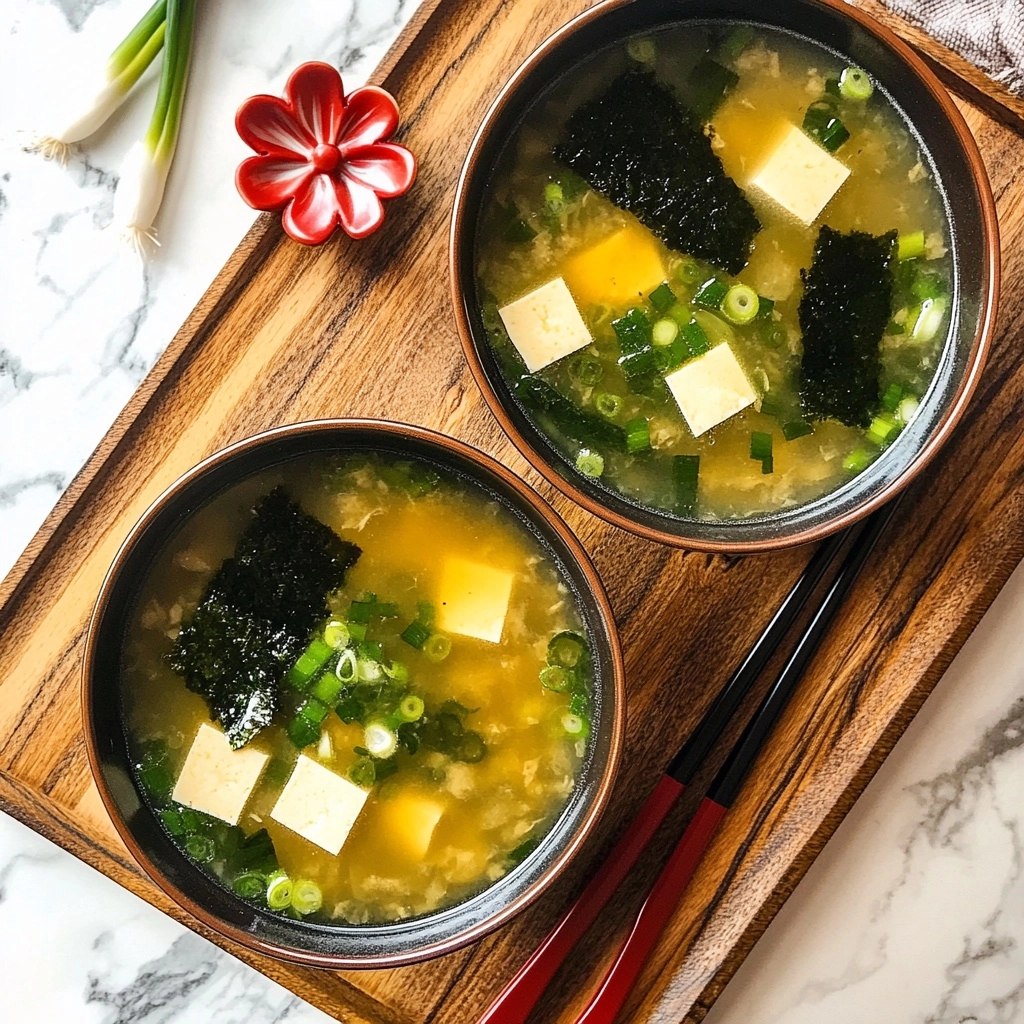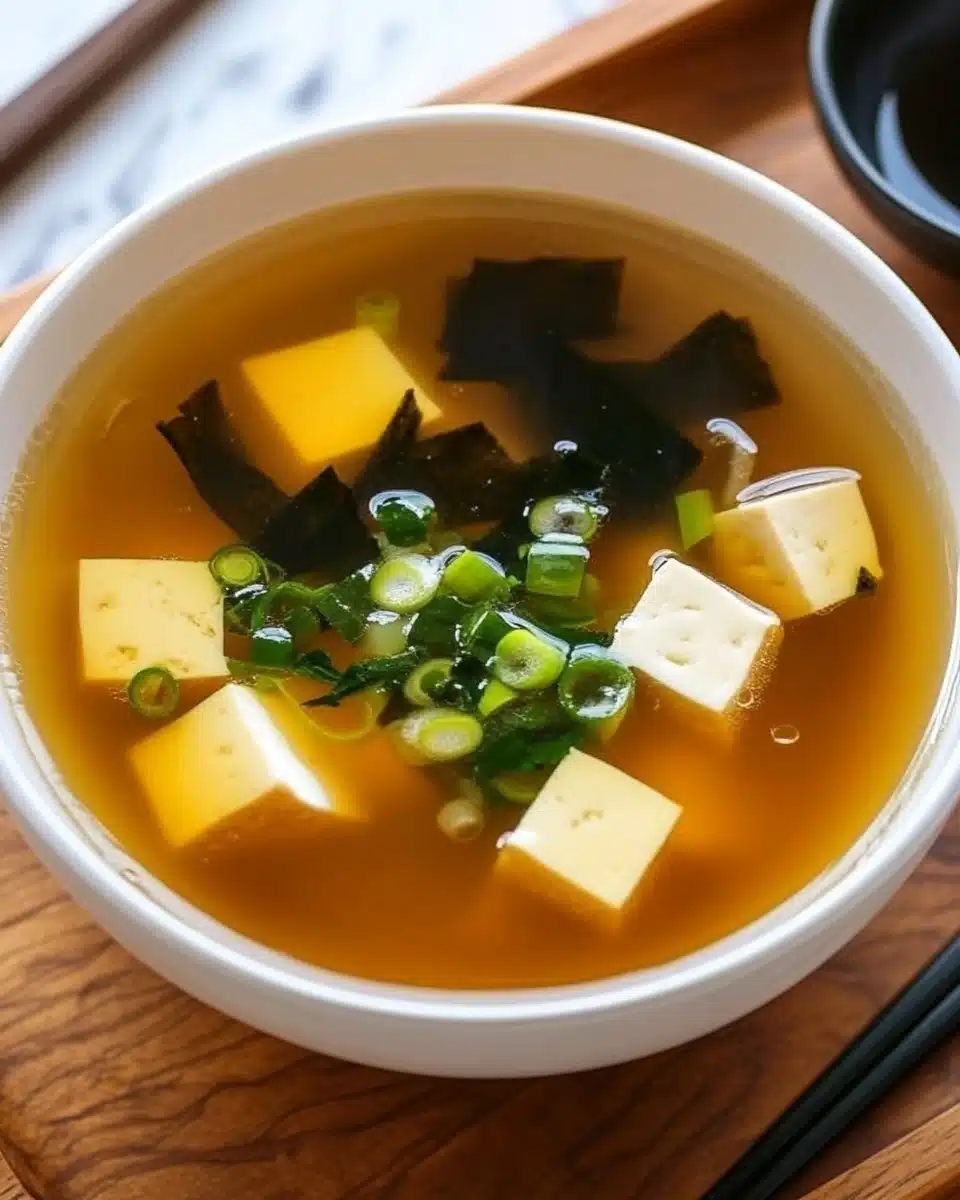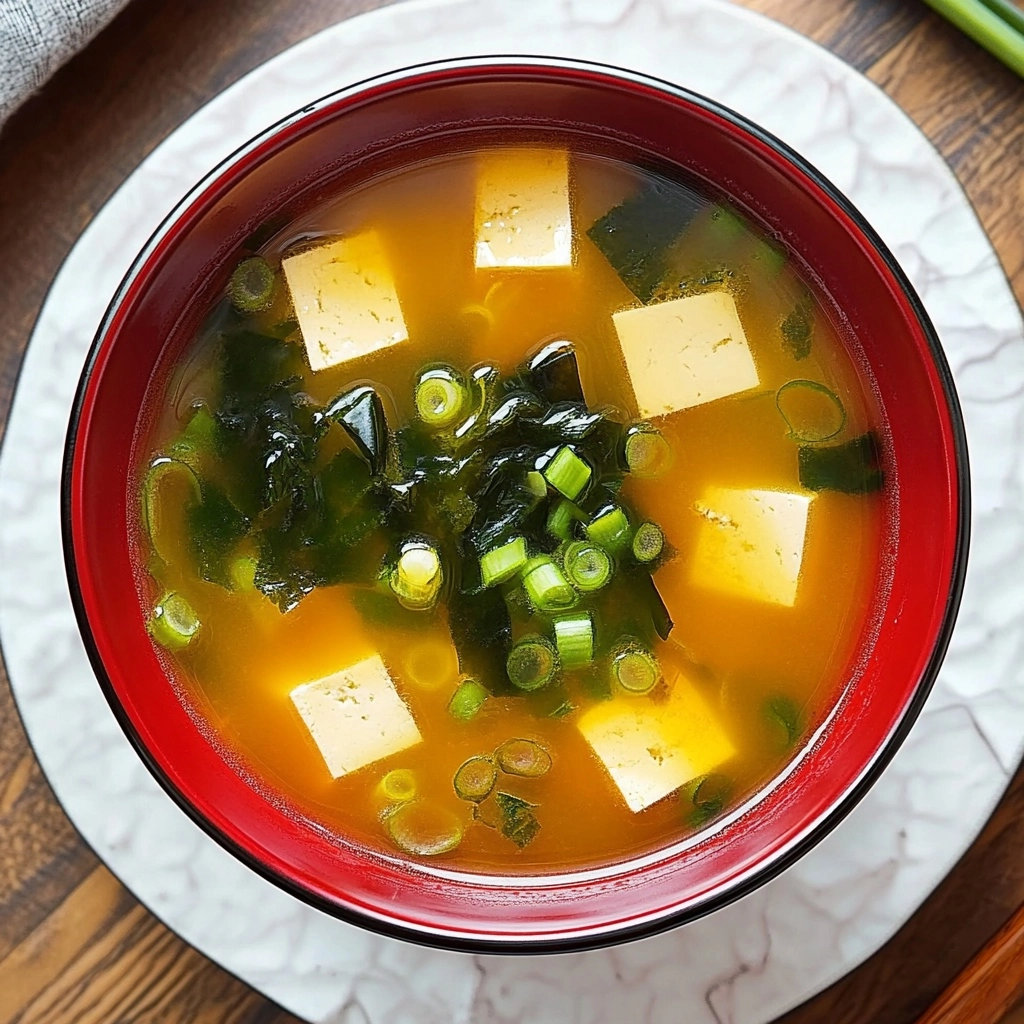There’s nothing quite as comforting as a bowl of Homemade Miso Soup with Tofu. This Japanese classic is a celebration of umami, silky tofu, and a warm embrace in every spoonful. If you’ve ever wanted to recreate that truly authentic restaurant flavor at home—plus control every wholesome ingredient—this recipe is for you!
Why You’ll Love This Recipe
- Truly Authentic: Every spoonful tastes just like the miso soup you adore at your favorite Japanese restaurant, thanks to homemade dashi and fresh miso.
- Customizable & Healthy: You decide the miso, tofu texture, and seaweed—plus it’s naturally gluten-free and protein-rich!
- Ready in Minutes: This comfort classic comes together in under 20 minutes from simple, wholesome pantry ingredients.
- Soothing for Body & Soul: Homemade Miso Soup with Tofu warms you from the inside out—ideal for chilly days or anytime you crave a little extra comfort.
Ingredients You’ll Need
The magic of Homemade Miso Soup with Tofu is how every ingredient serves a purpose—delivering depth, aroma, and that soul-satisfying texture. Don’t worry, these components are easy to find and oh-so-essential for that classic Japanese flavor we crave!
- Kombu (dried kelp): The cornerstone of dashi, kombu infuses the broth with a subtle oceanic umami. Never wash off its white powdery surface—it’s packed with flavor!
- Katsuobushi (dried bonito flakes): Adds smoky, complex savory notes and extra depth to the traditional dashi base. Look for it at Asian grocers or specialty markets.
- Water: Fresh, cold water is all you need to draw out the best from kombu and katsuobushi.
- Miso paste: Choose white (shiro) for gentle sweetness or red (aka) for robust flavor—whichever you love! Stirring in last preserves its bright taste and nutrients.
- Soft or silken tofu (kinugoshi dofu): Silky, custardy cubes add nourishment and irresistible melt-in-your-mouth appeal.
- Dried wakame seaweed: Just a pinch rehydrates into delicate green ribbons, bringing subtle brininess and vibrant color.
- Green onion (scallion): Sliced thin for a mild, fresh bite and classic garnish.
Variations
Homemade Miso Soup with Tofu can be as unique as you want it to be! This classic is so easy to adapt—swap out additions, make it vegan, or dial in the richness. Here are some tasty ways to mix things up based on your cravings or whatever’s in the fridge.
- Vegetarian or Vegan: Skip the bonito flakes to make Kombu Dashi, or add a dried shiitake mushroom when soaking the kombu for rich umami minus the fish.
- Broth Add-ins: Stir in baby spinach, thinly sliced mushrooms, or carrot matchsticks for extra veggies and color.
- Miso Variety: Try a blend of white and red miso for a balanced, layered flavor—or experiment with barley or chickpea miso if you’re feeling adventurous!
- Different Tofu: Swap in medium-firm tofu if you prefer a little bite, or try cubes of yuba (tofu skin) for a fun twist.
How to Make Homemade Miso Soup with Tofu
Step 1: Prep Your Ingredients
Begin by gathering everything you need: kombu, katsuobushi, tofu, miso paste, wakame, green onion, and water. Slice the green onion thinly and carefully cut your tofu into dainty half-inch cubes—the tofu is delicate, so use a sharp knife and a gentle hand. If you want extra color, prep any veggie add-ins now too!
Step 2: Make the Dashi Broth
Add water and kombu to a medium saucepan and let it soak for 30 minutes if you have time. Bring slowly to a bare simmer over medium-low heat—this teases out the kombu’s incredible umami. Just before boiling, remove the kombu to prevent bitterness. For a vegetarian version, your broth is ready! For classic awase dashi, add the katsuobushi, simmer briefly, then remove from heat. Let the bonito flakes settle, then strain for a crystal-clear, fragrant base.
Step 3: Dissolve the Miso Paste
Return the pot of dashi to gentle heat—but don’t let it boil! Place your miso paste in a ladle and add a little hot broth, stirring until it melts into a smooth, cloudy liquid. Swirl the dissolved miso into the pot. This keeps the flavor delicate and the nutritional benefits of miso at their peak.
Step 4: Add Tofu & Wakame
Carefully add the tofu cubes to the miso soup. Sprinkle in the dried wakame and let it bloom for just a minute—it swells up beautifully! For the freshest bite and emerald green color, add the green onions right before serving.
Step 5: Serve & Enjoy
Ladle Homemade Miso Soup with Tofu into bowls while it’s steaming—but not boiling! Grab your favorite soup chops or a spoon, and dive right in. This is comfort by the cup, just waiting for you at any time of day.
Pro Tips for Making Homemade Miso Soup with Tofu
- Never Boil the Miso: Always stir in miso off the heat or with very gentle warmth; boiling destroys its delicate flavor and many of its nutrients.
- Cube Tofu with Care: Use a sharp knife and slow, steady pressure to create beautiful, even cubes—this keeps them looking elegant and prevents breakage when stirring into the soup.
- Dashi on Demand: Homemade dashi can be made in advance and stored in the fridge for several days or frozen for speedy miso soup fixes anytime you’re craving comfort.
- Customize With Miso Types: White, yellow, or red miso all bring different personalities to your soup—try blending two for the best of both worlds!
How to Serve Homemade Miso Soup with Tofu

Garnishes
Classic Homemade Miso Soup with Tofu shines with a sprinkle of thinly sliced green onions and a pinch of extra wakame. For a little Japanese flair, add microgreens or a spiral of chili threads—you can even float a single edible flower for elegance. The key is freshness for both color and a little crunch!
Side Dishes
This soup is perfect as a light starter or comforting side. Pair it with homemade sushi rolls, a simple bowl of steamed white or brown rice, pickled vegetables, or a hearty chicken or tofu katsu for a nourishing meal that balances flavors and textures.
Creative Ways to Present
Serve Homemade Miso Soup with Tofu in small lacquered miso bowls for classic vibes, or use clear cups so your guests can admire the tofu and wakame floating like clouds. Add personalized chopstick rests or tiny wooden spoons for an extra-special touch!
Make Ahead and Storage
Storing Leftovers
Leftovers of Homemade Miso Soup with Tofu are best enjoyed within 1–2 days. Let the soup cool, then store in an airtight container in the fridge. Keep in mind the soup will lose some aroma over time, so try to finish it promptly for the freshest flavor!
Freezing
You can freeze the dashi base or the soup without tofu or miso for up to 2 weeks. If you freeze soup with tofu, be aware the texture will change—losing its silken softness. For best results, freeze the broth, then reheat and add fresh tofu and miso right before serving.
Reheating
Gently reheat Homemade Miso Soup with Tofu on the stovetop over medium-low heat—never let it boil! Boiling will dull the flavor of the miso (and may toughen the tofu), so aim for a warm, steamy bowl instead of a rolling boil.
FAQs
-
Can I use instant dashi powder instead of making my own?
Absolutely! While homemade dashi gives the most authentic and layered flavor, dashi powder is great for busy days. Just follow the package instructions and use it as your broth base; the rest of the recipe remains the same.
-
What type of miso should I use?
White (shiro) miso is sweet and mellow, red (aka) miso is richer and more savory—either works for Homemade Miso Soup with Tofu! You can even blend them to suit your taste. Look for non-GMO, organic miso for the purest flavor.
-
Is this recipe vegetarian or vegan?
Using only kombu for the dashi and skipping the bonito flakes makes this dish vegetarian and vegan! If you want more umami, add a dried shiitake mushroom to the kombu soaking water.
-
Can I prepare miso soup ahead and reheat it later?
Yes—with one caveat: miso tastes best when freshly stirred in. For meal prep, store the soup without miso, then add the miso paste only when reheating, just before serving, for the best aroma and flavor.
Final Thoughts
I hope you feel inspired (and hungry!) to whip up a pot of Homemade Miso Soup with Tofu in your own kitchen. Once you taste the gentle umami broth and creamy tofu, you’ll understand why this classic is a staple in Japanese homes—and may just become a favorite in yours, too. Happy slurping!
Print
Homemade Miso Soup with Tofu Recipe
- Prep Time: 5 minutes
- Cook Time: 15 minutes
- Total Time: 20 minutes
- Yield: 4 servings 1x
- Category: Soup
- Method: Stovetop
- Cuisine: Japanese
- Diet: Vegetarian
Description
Learn how to make flavorful Homemade Miso Soup with Tofu from scratch. This traditional Japanese soup is comforting and packed with umami flavors.
Ingredients
Dashi:
- 4 cups water
- 1 piece kombu (dried kelp) (1/3 oz, 10 g per piece; 4 x 4 inches or 10 x 10 cm)
- 1 cup katsuobushi (dried bonito flakes) (packed; I used a loosely packed 3 cups in the video for stronger flavor)
Miso Soup:
- 7 oz soft/silken tofu (kinugoshi dofu)
- 4 Tbsp miso (use 1 Tbsp, 18 g for every 1 cup, 240 ml of dashi)
- 1 Tbsp dried wakame seaweed
- 1 green onion/scallion
Instructions
- Dashi 3 Ways: Gather all the ingredients.
- Miso Soup Ingredients: Cut 1 green onion/scallion into thin rounds.
- To Make the Dashi (can make in advance): Add 4 cups water and 1 piece kombu to a saucepan. Slowly bring to a boil, remove kombu, and set aside. If not vegetarian, add bonito flakes, simmer, strain.
- To Make the Miso Soup: Add dashi to a pot, bring to a slow boil, add miso, tofu, wakame, and green onions. Serve immediately.
Notes
- Rehydrate dried wakame separately to reduce saltiness.
- Do not boil miso soup when reheating.
- Store miso soup without miso for longer shelf life.
Nutrition
- Serving Size: 1 bowl
- Calories: Approx. 150 kcal
- Sugar: 2g
- Sodium: 500mg
- Fat: 8g
- Saturated Fat: 1g
- Unsaturated Fat: 4g
- Trans Fat: 0g
- Carbohydrates: 10g
- Fiber: 2g
- Protein: 10g
- Cholesterol: 0mg



